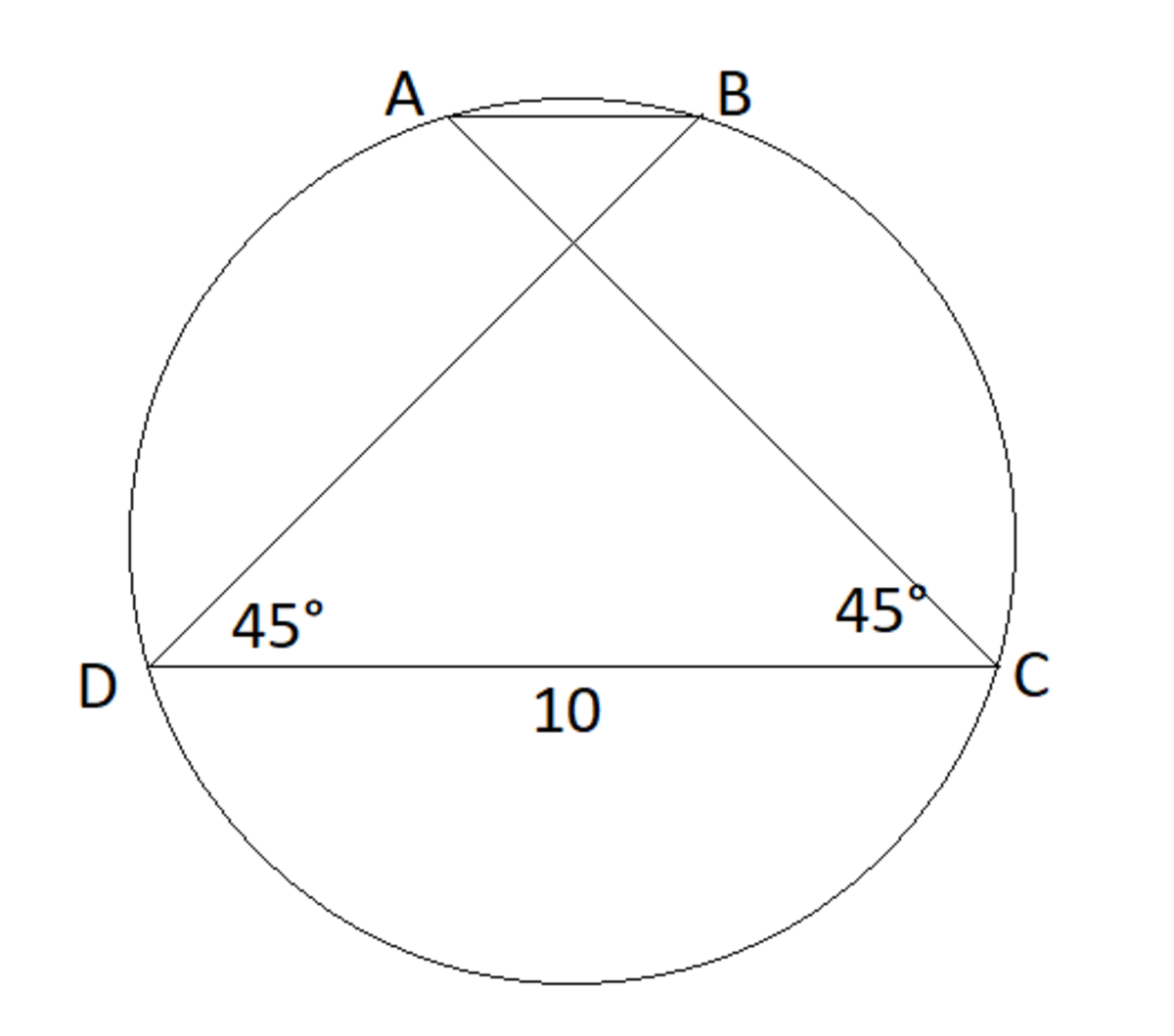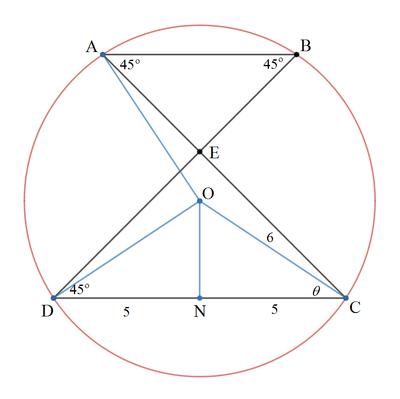Chords in a circle
A circle of radius 6 has parallel chords A B and C D in it. It is given that ∠ A C D = ∠ B D C = 4 5 ∘ , and that C D = 1 0 , then A B = N . Enter N as your answer.

Diagram not drawn to scale
The answer is 44.
This section requires Javascript.
You are seeing this because something didn't load right. We suggest you, (a) try
refreshing the page, (b) enabling javascript if it is disabled on your browser and,
finally, (c)
loading the
non-javascript version of this page
. We're sorry about the hassle.
4 solutions

Let A C and B D intersect at E , the center of the circle be O , and O N be perpendicular to C D . Then C N = D N = 5 , and O N = O C 2 − C N 2 = 6 2 − 5 2 = 1 1
Let ∠ O C D = ∠ O D C = θ . Then
A C A E ⟹ A B = 2 ⋅ O C ⋅ cos ∠ O C E = 2 ⋅ 6 cos ( 4 5 ∘ − θ ) = 1 2 ( cos 4 5 ∘ cos θ − sin 4 5 ∘ sin θ ) = 6 2 ( 6 5 − 6 1 1 ) = 5 2 − 2 2 = A C − C E = 5 2 − 2 2 − C D cos 4 5 ∘ = 5 2 − 2 2 − 5 2 = 2 2 = A E ⋅ sec 4 5 ∘ = 2 2 ⋅ 2 = 4 4
Therefore N = 4 4 .
Let O be the centre of the circle, let M be the midpoint of AB and N be the midpoint of CD, and let P be the intersection of AC and BD. Furthermore, let AM = half of AB be x .
ND = 10/2 = 5, and OD = 6 (radius), so ON = 6 2 − 5 2 = 1 1 . Meanwhile, DN = PN, so PN = 5, and similarly, MP = x. Thus OP = PN - ON = 5 − 1 1 .
Now A M , P O form the legs of a right triangle, and A O is the hypotenuse. A O = 6 as it is also a radius. Hence x 2 + ( x + 5 − 1 1 ) 2 = 6 2 , so x 2 + x 2 + 2 ( 5 − 1 1 ) x + 3 6 − 1 0 1 1 = 3 6 ⇒ 2 x 2 + ( 1 0 − 2 1 1 ) x − 1 0 1 1 = 0 ⇒ x 2 + ( 5 − 1 1 ) x − 5 1 1 = 0 .
Factorising gives ( x + 5 ) ( x − 1 1 ) = 0 ⇒ x = − 5 , 1 1 . Since x has to be positive, x = 1 1 only. Finally, remember that A B = 2 x = 2 1 1 = 4 4 , hence N = 4 4 .
Let circle center is O, CD's midpoint is M and AC's midpoint is N, intersection of AC and BD is P: O M = O C 2 − ( 2 C D ) 2 = 6 2 − 5 2 = 1 1 P M = 2 C D = 5 O P = P M − O M = 5 − 1 1 O N = 2 O P = 2 5 − 1 1 A N = A O 2 − O N 2 = 6 2 − ( 2 5 − 1 1 ) 2 = 2 5 + 1 1 A P = A N − P N = 2 5 + 1 1 − 2 5 − 1 1 = 2 2 A B = A P 2 = 4 4 ∴ N = 4 4
Let A C and B D intersect at E , and let the center of the circle be O so that O B = O C = 6 .
Since central ∠ B O C subtends the same arc as inscribed ∠ B D C , ∠ B O C = 2 ⋅ ∠ B D C = 2 ⋅ 4 5 ° = 9 0 ° .
From right isosceles △ B O C , B C = 6 2 , and from right isosceles △ E D C , E C = 2 1 0 .
Then by the Pythagorean Theorem on △ B E C , B E = ( 6 2 ) 2 − ( 2 1 0 ) 2 = 2 2 , so that from right isosceles △ A B E , A B = 2 2 ⋅ 2 = 4 4 .
Therefore, N = 4 4 .